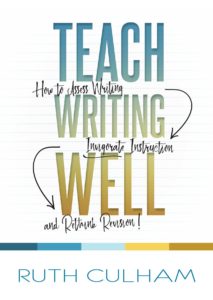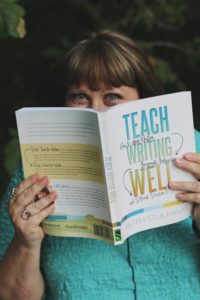Ruth Culham 
Truth. We live in an educational world of high standards and pathetically few resources. Every year teachers and schools are asked to do more with less. And, short of opening up the state and national checkbooks and finally funding schools the way they deserve, it’s going to stay that way. I can’t help but wonder if other essential professions have to operate like this. Likely not. School funding should be like my parents taught me about saving: Pay yourself first. Put money aside for the future and then deal with rent, groceries, car payment, and living expenses. Americans should pay schools first, plain and simple. But, until that day, there are things we can do with the resources we have to accomplish more.
Writing in Today’s Classrooms
Writing is a big deal in today’s classrooms for all the right reasons. Writing is thinking and clear thinking is required for everything a student does and will want to do throughout his or her life. And yet, it’s not an instructional area of strength and confidence for most teachers. Almost every educator I know, at every level and across the country⎯North, South, East, and West⎯asks the same question: How do I improve student writing? The truth is, most teachers are not adequately prepared to teach writing and a great many do not feel they received any help in college to teach this critical subject. In my work with assessing and teaching writing for the past 30 years, I have often found that teachers are not aware of the most dynamic and proven writing practices, defaulting to the same ones they were subjected to during their own formative years–practices that created generations of adults who have no confidence in the quality of their writing and therefore avoid it like the plague.
Given that writing is a collective goal and that resources to teach writing well are not likely to come flooding in any time soon, it behooves us to look for help at what is already present in every classroom: print and nonprint materials. For a highly successful and extremely motivating way to engage students in reading AND writing, one of the best teaching strategies I know is to share high-quality books and resources for more than their original reading purpose⎯to see them as sources of writing models, too. Reading like a writer. Here’s what I mean.
Reading Like a Writer
Regardless of how you organize your reading instruction, a stunning novel such as Wonder by R. J. Palacio is likely in the reading lives of one or more students in your classroom. You hear students talking about it, you see how they eagerly pass the book around, you feel the palpable energy of this text. Terrific. This is exactly the buzz we’d hope a fine book would create. But don’t let it stop there. Aside from what students can learn about reading from Wonder, ask yourself what can be mined from the book about writing, too. The book is already in the classroom, accessible to students, so why not use it to teach reading’s fraternal twin: writing.
A quick browse through Wonder and I found passages on almost every page that illustrate different traits of writing. (see culhamwriting.com for the scoring guides and additional print resources that define the traits and their key qualities: ideas, organization, voice, word choice, sentence fluency, and conventions.)
One quick example:
Pg. 156: I shrugged but I didn’t say anything. I just couldn’t. If I told him that Julian had called August a freak, then he’d go talk to Julian about it, then Julian would tell him how I had bad-mouthed August, too, and everybody would find out about it. (Sentence Fluency: Varying Sentence Patterns)
Once you find a passage that is a model of good writing for a particular reason, share it with students. With their student-friendly versions of the traits of writing scoring guides in hand (www.culhamwriting.com) they can pinpoint what the author has done well and discuss it using the shared vocabulary so essential to understanding how writing works and being able to talk about it. For instance, in this passage, the author has created rhythm and a smooth sound to the reader’s ear by using a variety of sentence lengths. Challenge students to find passages from other favorite texts that vary sentence patterns and share them. Then ask them to find a place in their own writing and revise several sentences so they vary in length similar to Palacio’s.
The print and nonprint materials you have in your classroom and school library are a rich resource for teaching writing. And the beauty of using them is two-fold: 1) you already have access to them and 2) modeling from mentor texts is a powerful instructional technique for teaching writing. For more detail and examples, my book, The Writing Thief, (Stenhouse, 2014) might be helpful.
Closing Thoughts
Bottom line: We must learn how to do more with less in this age of school funding woes. But good news! If you have a classroom library, you already have what you need to move writing instruction forward with energy and success. How to plan a year, week, and day of writing instruction with resources already on hand are found in Teach Writing Well, by Ruth Culham, Stenhouse 2018. With access to proven strategies, regardless of your preparation in college or your experience as a teacher, you can turn teaching writing from cringe-worthy to credible to completely phenomenal.

Palacio, R.J. (2012). Wonder. New York: Knopf Books for Young Readers.
Ruth Culham lives in Beaverton, Oregon with her two cats and her always-ready-to-write computer. She creates professional books and materials for teaching writing based on the traits of writing and conducts professional development workshops for teachers and administrators across the country and world. Her most recent book, Teach Writing Well, is based on 30+ years of teaching, researching, and learning about what works and what doesn’t work for classroom teachers.
![]()













